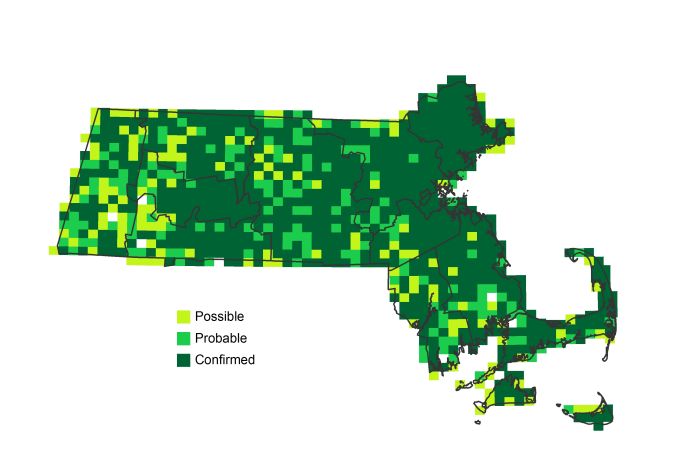Breeding Bird Atlases (BBA)
Find a Bird
Downy Woodpecker
Picoides pubescens

Nearly ubiquitous and likely increasing
“As for farming, I am convinced that my genius dates from an older era than the agricultural. I would at least strike my spade into the earth with such careless freedom but accuracy as the woodpecker his bill into a tree.” – Henry David Thoreau, A Week on the Concord and Merrimack Rivers
The Downy Woodpecker is the commonest and smallest woodpecker in Massachusetts, and in fact holds these titles for our continent as a whole. They are frequent visitors to winter feeders, especially suet feeders, and can be found fairly easily in all regions of the state year-round. The species ably withstood the period of Massachusetts history wherein most of our forests were felled to make room for farmland. Now that the forests are returning, Downy Woodpeckers are in their element.
Historic Status
Where there are trees in the United States, there likely are Downy Woodpeckers, and so it has been since the earliest observers of birds moved throughout the country. “I have found it pretty generally distributed from the lower parts of Louisiana to Labrador,” said John James Audubon, “and as far to the westward as I have traveled. It seems, in fact, to accommodate itself to circumstances, and to live contented anywhere” (Audubon 1840). Massachusetts has never been an exception.
Atlas 1 Distribution
Common and familiar, Downy Woodpeckers were predictably widespread during Atlas 1. West of the Berkshire Transition and Vermont Piedmont, Downys were present in just about every block. They were also widely distributed in the Connecticut River Valley but puzzlingly absent from sections of the Worcester Plateau, which may have been due to survey effort. Throughout the Coastal Plains and the Boston Basin, Downy Woodpeckers were very prevalent, and only slightly less so in the Bristol/Narragansett Lowlands. The Cape and Islands had Downy Woodpeckers in just over half of all blocks, including at least a few on both major Islands.
Atlas 2 Distribution and Change
The Atlas 2 surveys found Downy Woodpeckers to be even more widespread than they were in the 1970s. Any block having even a few trees was virtually ensured to host Downy Woodpeckers during the breeding season, and suburban (or even urban) development did not appear to faze these adaptable woodpeckers in the slightest. So successful and broadly distributed was this species that not a single ecoregion reported less than 80% block occupancy in Atlas 2, and all but one had 90% occupancy or more. Although Cape Cod and the Islands had the lowest absolute block occupancy, many of the blocks from which the species was absent were coastal blocks with little land area. The offshore islands particularly exhibited considerable Downy Woodpecker expansion during the inter-Atlas period.
Atlas 1 Map

Atlas 2 Map

Atlas Change Map

Ecoregion Data
Atlas 1 | Atlas 2 | Change | ||||||
Ecoregion | # Blocks | % Blocks | % of Range | # Blocks | % Blocks | % of Range | Change in # Blocks | Change in % Blocks |
Taconic Mountains | 14 | 87.5 | 1.8 | 23 | 92.0 | 2.3 | 1 | 6.7 |
Marble Valleys/Housatonic Valley | 39 | 100.0 | 5.1 | 39 | 100.0 | 4.0 | 0 | 0.0 |
Berkshire Highlands | 52 | 94.5 | 6.8 | 55 | 100.0 | 5.6 | 2 | 3.8 |
Lower Berkshire Hills | 27 | 96.4 | 3.5 | 28 | 90.3 | 2.8 | -2 | -7.4 |
Vermont Piedmont | 12 | 70.6 | 1.6 | 17 | 100.0 | 1.7 | 2 | 16.7 |
Berkshire Transition | 31 | 81.6 | 4.0 | 39 | 97.5 | 4.0 | 4 | 12.9 |
Connecticut River Valley | 54 | 96.4 | 7.0 | 62 | 95.4 | 6.3 | 1 | 2.1 |
Worcester Plateau | 54 | 69.2 | 7.0 | 87 | 98.9 | 8.8 | 12 | 25.0 |
Lower Worcester Plateau | 54 | 73.0 | 7.0 | 80 | 100.0 | 8.1 | 5 | 9.3 |
S. New England Coastal Plains and Hills | 221 | 81.9 | 28.8 | 278 | 98.2 | 28.3 | 25 | 11.1 |
Boston Basin | 44 | 78.6 | 5.7 | 52 | 92.9 | 5.3 | 7 | 12.7 |
Bristol and Narragansett Lowlands | 89 | 84.0 | 11.6 | 107 | 93.9 | 10.9 | 11 | 10.9 |
Cape Cod and Islands | 77 | 56.6 | 10.0 | 117 | 81.3 | 11.9 | 30 | 25.0 |
Statewide Total | 768 | 79.3 | 100.0 | 984 | 94.9 | 100.0 | 98 | 11.8 |
Notes
In accordance with Atlas increases, the Downy Woodpecker shows significant increasing Breeding Bird Survey trends in Massachusetts, the New England/Mid-Atlantic Region, and in the Eastern US overall.



